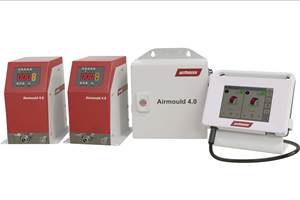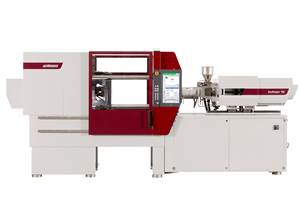New Processes Give Automotive Molders An Edge in Cost and Productivity
Car makers' all-out effort to cut costs is giving rise to new paint-free technologies, including an innovative 'simultaneous-shot" injection molding process that was presented at the SPE Automotive Division's latest annual Innovation Awards ceremony.
Car makers' all-out effort to cut costs is giving rise to new paint-free technologies, including an innovative 'simultaneous-shot" injection molding process that was presented at the SPE Automotive Division's latest annual Innovation Awards ceremony. Other cost-cutting developments that won awards included the first commercial use of gas assist in compression molding, the longest blow molded running board produced to date, and the industry's first 'ship-in-a-bottle" blow molded fuel tank.
Two-tone IP avoids paint
Visteon Automotive Systems, Saline, Mich., teamed up with Husky Injection Molding Systems to develop a two-color polypropylene instrument panel for the 2005 Ford Mustang. Husky's simultaneous-shot injection process uses traditional two-shot injection technology, but without the rotary table, to give a two-tone look without painting. The technique, which won the award in the Process/Assembly/ Enabling Technologies category, involves simultaneous injection of two colors into the mold from two different injection units on the machine. Flow fronts are controlled by opening and closing valve gates based on screw position in each injection unit.
Computerized flow-front simulation to predict filling of the two colors, together with sequential valve-gate tooling from Synventive, resulted in positioning of knit lines in a non-conspicuous location covered by a separate trim piece. Husky's 1800-ton Quadloc Dual 1650 two-shot machine molds the IP in a little over 60 sec, which is a typical cycle time for a standard IP.
Simultaneous-shot injection involves lower risk and lower investment than traditional two-shot molding in this application, according to Husky. In the Mustang project, concept to production took less than six months. Capital investment is about 70% less than a standard two-shot system and tooling cost is 45% to 55% less, says Husky. In comparison to a typical painted IP, the Husky process reaps a direct labor savings of 12.9% and indirect labor savings of $240,000/yr.
The Mustang IP is claimed to be the first use of simultaneous-shot injection in a large part. Previously, small two-shot parts were produced via simultaneous-shot transfer molding using a robot to transfer parts rather than a rotary cable. With a continuing trend toward two-color IPs and door panels, Husky expects growing use of simultaneous-shot molding in interior panels and trim.
A second two-shot molding earned the SPE Materials award. This rear deck lid touch-off molding replaces stamped metal and an extruded seal on the Ford 2005 Mustang convertible. It is injection molded of 33% glass-filled nylon (supplied by A. Schulman) overmolded with a seal component made of Zeon Chemicals" new Zeotherm 100 series 'super-TPV." It's a dispersion of crosslinked acrylic rubber in nylon, which chemically bonds to the nylon substrate, providing consistent adhesion along the entire length of the part. This adhesion is retained under the sun and heat of the Southwest, where conventional TPEs were prone to delamination, according to Zeotherm sources.
‘Ship in a bottle"
TI Automotive, Auburn Hills, Mich., claims a significant breakthrough in blow molded fuel tanks with its 'ship-in the-bottle" (SIB) design for the Ford GT. It economically integrates fuel-system components such as fuel-delivery modules, baffles, and level senders. The elimination of the need to cut holes to insert these components and then weld over the holes reportedly cuts both cost and hydrocarbon evaporative emissions.
The new SIB system did not use off-the-shelf processes, according to James Osborne, fuel-systems development engineering manager. Among the batch of new manufacturing elements developed by TI Automotive was a patent-pending articulated mold and a new offset parison spreader that opened the parison enough so the rigid carrier incorporating the fuel-delivery system could be inserted into the mold. Another key element is a custom multi-function blow pin that orients the carrier and cycles the blowing air. Also developed was a method to allow functional testing of a tank assembly's operating components before integration into a tank. The six-layer HDPE tank was produced on a Kautex machine.
TI Automotive estimates a 20% to 30% savings in ancillary finishing equipment and a significant reduction in scrap via elimination of welds and required destructive testing. Production volume for the 17.5-gal tank is about 1800 units/yr. Osborne said TI Automotive also used the SIB system for the Land Rover in Europe six months after the Ford GT. Other applications are in the pipeline, mainly in Europe.
Another achievement for blow molding was an SUV running board that sets a new mark for length. The one-piece, 2311-mm-long board for the 2005 General Motors GMT 800, which won the Body Exterior award, was developed by ABC Group, Toronto. It replaces a multi-component system consisting of an SMC substrate and injection molded covers.
Central to the development was the creation of a new blow molding machine because of the unavailability of a suitable large-part unit. The homemade, 25-ft-high machine has a long, thin clamp, a special nozzle head, and a fully automated takeout and trimming system. ABC Group constructed several of these machines to handle production volumes of 600,000 parts. Salflex Polymers, an ABC Group subsidiary, developed a special 15% glass-filled PP that met the hang-strength re quirement of the 2.5-meter-long parison.
Gas-assist compression
Gas-assist thermoplastic compression molding won its first commercial use in an aftermarket towing package from Cequent Towing Products, Plymouth, Mich. Molder Composite Technologies Co. (CTC), Dayton, Ohio, and the former Alliance Gas Systems (now FAME), Chesterfield Township, Mich., whose patents were recently acquired by Cinpres Gas Injection, developed the technology. CTC has its own patents on the technology, which earned top honors in the Performance and Customization category.
A 7.25-lb billet is extruded from recycled PP with 25% long glass, compounded by CTC. The billet is placed on the lower mold half in a vertical press. The mold is closed and a patented reciprocating pin penetrates the billet and injects gas to core out the part. Cycle time is less than 1 min.
Gas assist reduces wall thickness by up to 50%, resulting in reduced warpage and sink marks. Cooling time is reduced and productivity is increased, according to CTC. Other potential uses for the new process include consumer products, automotive running boards, and material handling trays and totes.
One-piece IP carrier
An IP carrier that re places stamped and welded steel is a first for metal/plastic hybrids, says Quadrant Plastic Composites. The one-piece design used in several vehicle lines for Ford, Volvo, and Mazda encapsulates the steel cross-car beam with compression molded PP glass-mat thermoplastic (GMT) sheet. (Previous metal/plastic hybrids appeared in auto front ends made by injection molding.) The molding, which shared the Body Interior award, integrates the air ducting, airbag support, steering-column support, and knee bolster.
Quadrant developed GMT E100F, a new 40% long-glass PP with unusually long fiber lengths of about 2 in. The new grade provided higher impact strength at 2 kg lower weight. Quadrant says the hybrid carrier meets or exceeds all U.S., European, and other crash-safety standards and performs better in some tests than the steel design. Production volume is 700,000 parts/yr for six instrument panels molded for 12 vehicles.
Tier 1 supplier Faurecia Molding Div. in France won a process patent for proprietary tooling designed to completely encapsulate the hollow steel tube without crushing it during molding in high-speed compression presses of 1500 to 2000 tons. The tooling promotes optimum glass flow so the steel tube is fully encapsulated at junction points by the GMT. This eliminates knit lines and helps prevent the steel tube from tearing away from the IP carrier during a crash. A cost-saving measure was a special tooling insert that allowed IPs for both left- and right-side drive vehicles to be molded from the same mold.
Related Content
Internal Gas Pressure Molding Offers Sustainability Benefits
Wittmann Battenfeld says its upgraded Airmould 4.0 technology, which features a more compact footprint, saves material and cycle time — thereby also cutting energy use.
Read MoreCompletely Connected Molding
NPE2024: Medical, inmold labeling, core-back molding and Industry 4.0 technologies on display at Shibaura’s booth.
Read MoreFakuma 2023: Wittmann Battenfeld Expands All-Electric Line, Direct-Current Capabilities
Wittmann Battenfeld will introduce the new EcoPower B8X injection molding machine line and show direct current as an energy source for a concept machine that will power its own robot.
Read MoreStructural Foam Injection Molding Line Extended
At K 2022, Wilmington Machinery introduced the dual-injection Lumina MP1200 medium pressure molding machine.
Read MoreRead Next
Lead the Conversation, Change the Conversation
Coverage of single-use plastics can be both misleading and demoralizing. Here are 10 tips for changing the perception of the plastics industry at your company and in your community.
Read MorePeople 4.0 – How to Get Buy-In from Your Staff for Industry 4.0 Systems
Implementing a production monitoring system as the foundation of a ‘smart factory’ is about integrating people with new technology as much as it is about integrating machines and computers. Here are tips from a company that has gone through the process.
Read MoreWhy (and What) You Need to Dry
Other than polyolefins, almost every other polymer exhibits some level of polarity and therefore can absorb a certain amount of moisture from the atmosphere. Here’s a look at some of these materials, and what needs to be done to dry them.
Read More



































